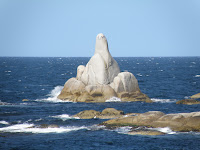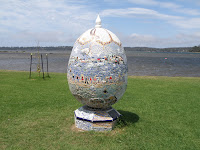20th February 2011
 It rained quite heavily and almost continually for the last two days and was quite windy, but today for the first time since we started our road trip the wind has become so strong that we have taken down our annex before the wind takes it down for us. We have experienced strong winds before but we were more sheltered in other areas by hills, fences or buildings, but here in Low heads near George Town we are very exposed on the east shore of the Tamar river estuary which allows the 40 knot wind to hit us head-on. When the wind changes direction it comes across an open field from the ocean behind us, as we are on a point so we don’t get any relieve from the change of direction.
It rained quite heavily and almost continually for the last two days and was quite windy, but today for the first time since we started our road trip the wind has become so strong that we have taken down our annex before the wind takes it down for us. We have experienced strong winds before but we were more sheltered in other areas by hills, fences or buildings, but here in Low heads near George Town we are very exposed on the east shore of the Tamar river estuary which allows the 40 knot wind to hit us head-on. When the wind changes direction it comes across an open field from the ocean behind us, as we are on a point so we don’t get any relieve from the change of direction.21st January2011
Today the wind is not so severe but still cold and holding the temperature down to 20° despite the effort of the sun.

 We drove down to West Launceston to the Penny Royal which is listed as a tourist attraction for some reason. It is a motel/restaurant and private apartment complex with a difference, in so much as it was disassembled from its original site with every stone numbered and rebuild at the side of the Gorge.
We drove down to West Launceston to the Penny Royal which is listed as a tourist attraction for some reason. It is a motel/restaurant and private apartment complex with a difference, in so much as it was disassembled from its original site with every stone numbered and rebuild at the side of the Gorge. 
 Each apartment has a different frontage with a castle gate entrance to the rear area. We moved the car down to the waterside by Royal Park and bought lunch at a fish & chip takeaway and then walked through the small park by which time the tide had come in sufficiently to cover the mudflats that appear at low tide.
Each apartment has a different frontage with a castle gate entrance to the rear area. We moved the car down to the waterside by Royal Park and bought lunch at a fish & chip takeaway and then walked through the small park by which time the tide had come in sufficiently to cover the mudflats that appear at low tide. We then drove out to Deloraine and on a further 10km along the Mole Creek road to a salmon farm called 41° South to buy some hot smoked salmon which Merry was introduced to by the people we chatted with at Evercreech Forest Reserve. We met another couple there that were looking for Montana Falls and helped them look for it after consulting the management at the salmon farm for directions. We never found them so returned to George Town via an alternate, shorter route via Exeter. We discovered that the Bell Bay Power station down the road from George Town has gas fired turbines with the natural gas being supplied by an underwater pipeline from Victoria and that there is also a DC power connecting cable from George Town to Victoria so that they can trade power when required. The system uses Earth as the return conductor just like using a car body as the return conductor, and the DC is changed to AC via invertors at up to 600Mw at a time. The actual power station was built as a back up to the Hydro system for times of drought and therefore, is hardly ever used.
22nd February 2011
We attempted to visit the Bell Bay harbour, which is supposedly the busiest harbour in Tasmania, but gates avoid anyone getting too close, so we moved on to Mt George lookout for an overview of the area.
On a clear day such as today it is possible to see the top of the suspension framework of Batman bridge, the head gear at Beaconsfield Gold Mine and the lighthouse on the end of the point. From there we moved on to look at the mural on the local water tower and then on to Bell Buoy Beach where the tide was well and truly in, and excluded any beach.
We had already put the annex and awning away because of the wind a few days ago and haven’t bothered to set them up again just for a few days, which made it very easy to do a final pack up today to head for Devonport where we are very close to the Ferry terminal as we have to be at the terminal at 6.30am on Monday. We can watch the Spirit of Tasmania come and go a few times whilst we are here.
 The 13 month tour of Tasmania to all intents and purposes is over with a short drive around Devonport. We have missed a few small townships as it not possible to see, or do, everything but we have done enough to claim that we have genuinely seen Tasmania.
The 13 month tour of Tasmania to all intents and purposes is over with a short drive around Devonport. We have missed a few small townships as it not possible to see, or do, everything but we have done enough to claim that we have genuinely seen Tasmania. We have spent a week, but usually 2 weeks or more, at 21 of the recognised tourist places and used them as a base from which to tour the surrounding area within a 60km radius, which has covered almost all of the main roads, many minor roads and quite a few unsealed roads. We have:
visited towns that are noted for their murals, their topiary or even their oddball letter boxes
and visited others towns that are known for their fantastic pepper/steak pies or pancakes.
visited 22 waterfalls (three of them twice)
watched a blowhole perform
visited at least six museums with the Zeehan Mining Museum being the best with Hobart a close second.
watched powerboat racing and a surf lifesaving championships
enjoyed a rack and pinion train trip
been around when the world record number of water skiers behind one boat was achieved
been down 3 caves (one of which has just been re-opened since it flooded)
taken 5 boat trips, other than the ferry to Tassie and the ferry to Bruny Island.
been to the Launceston Festivale and Carrick Agricultural Show
been to the Echidna and Platypus park, the Tasmania Zoo, the Seahorse aquarium, the Beaconsfield mine
explored the remains of old mining towns
visited markets and sampled several local cheeses and wines
driven along more roads with sheer drops off one side more times than you can shake a stick at.
driven over numerous mountains because you have to
seen most wildlife associated with Tassie
walked for hours through rainforests
climbed many lookouts for great views
met many friendly people including some we knew in WA
Best of all we had the bonus company of Stu and Be and their respective parents on several occasions.
The only thing we haven’t experienced is summer and genuine warm weather. Tasmania is a beautiful state but unfortunately going nowhere due to a pathetic local government that has been in power way too long, and they also have shocking narrow roads and woeful drivers.
26th February 2011
We drove through to the other side of Latrobe to the Cherry Shred bought some cherries which in fact were classified as seconds due to slight rain damage but were still better than the cherries in the supermarkets and only half the price. As it was nearly an acceptable lunch time we also submitted to a cherry pancake with cherry/chocolate ice cream which went down quite nicely. In the late afternoon we walked from the caravan park to Pardoe Beach, back to the Ferry Terminal and then back to the Park but that walk didn’t reveal anything special, just a 3.6km walk.
27th February 2011
We did our final preparation in readiness for our move to the Ferry Terminal at the crack of dawn tomorrow morning.








































